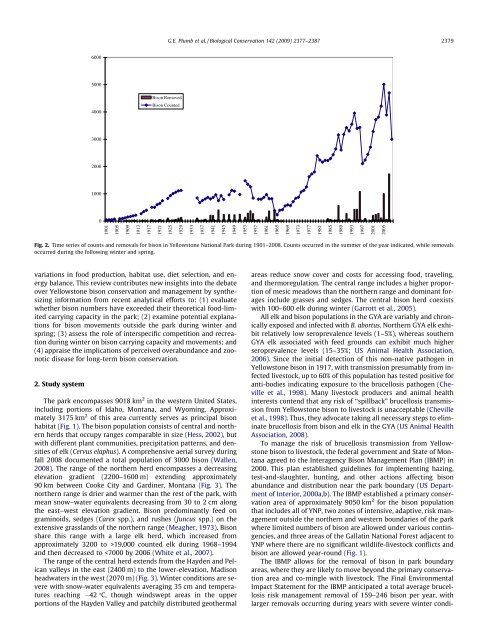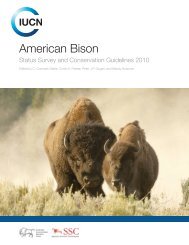Carrying capacity, migration, and dispersal in ... - ResearchGate
Carrying capacity, migration, and dispersal in ... - ResearchGate
Carrying capacity, migration, and dispersal in ... - ResearchGate
You also want an ePaper? Increase the reach of your titles
YUMPU automatically turns print PDFs into web optimized ePapers that Google loves.
variations <strong>in</strong> food production, habitat use, diet selection, <strong>and</strong> energy<br />
balance. This review contributes new <strong>in</strong>sights <strong>in</strong>to the debate<br />
over Yellowstone bison conservation <strong>and</strong> management by synthesiz<strong>in</strong>g<br />
<strong>in</strong>formation from recent analytical efforts to: (1) evaluate<br />
whether bison numbers have exceeded their theoretical food-limited<br />
carry<strong>in</strong>g <strong>capacity</strong> <strong>in</strong> the park; (2) exam<strong>in</strong>e potential explanations<br />
for bison movements outside the park dur<strong>in</strong>g w<strong>in</strong>ter <strong>and</strong><br />
spr<strong>in</strong>g; (3) assess the role of <strong>in</strong>terspecific competition <strong>and</strong> recreation<br />
dur<strong>in</strong>g w<strong>in</strong>ter on bison carry<strong>in</strong>g <strong>capacity</strong> <strong>and</strong> movements; <strong>and</strong><br />
(4) appraise the implications of perceived overabundance <strong>and</strong> zoonotic<br />
disease for long-term bison conservation.<br />
2. Study system<br />
6000<br />
5000<br />
4000<br />
3000<br />
2000<br />
1000<br />
0<br />
1901<br />
1905<br />
1909<br />
1913<br />
The park encompasses 9018 km 2 <strong>in</strong> the western United States,<br />
<strong>in</strong>clud<strong>in</strong>g portions of Idaho, Montana, <strong>and</strong> Wyom<strong>in</strong>g. Approximately<br />
3175 km 2 of this area currently serves as pr<strong>in</strong>cipal bison<br />
habitat (Fig. 1). The bison population consists of central <strong>and</strong> northern<br />
herds that occupy ranges comparable <strong>in</strong> size (Hess, 2002), but<br />
with different plant communities, precipitation patterns, <strong>and</strong> densities<br />
of elk (Cervus elaphus). A comprehensive aerial survey dur<strong>in</strong>g<br />
fall 2008 documented a total population of 3000 bison (Wallen,<br />
2008). The range of the northern herd encompasses a decreas<strong>in</strong>g<br />
elevation gradient (2200–1600 m) extend<strong>in</strong>g approximately<br />
90 km between Cooke City <strong>and</strong> Gard<strong>in</strong>er, Montana (Fig. 3). The<br />
northern range is drier <strong>and</strong> warmer than the rest of the park, with<br />
mean snow–water equivalents decreas<strong>in</strong>g from 30 to 2 cm along<br />
the east–west elevation gradient. Bison predom<strong>in</strong>antly feed on<br />
gram<strong>in</strong>oids, sedges (Carex spp.), <strong>and</strong> rushes (Juncus spp.) on the<br />
extensive grassl<strong>and</strong>s of the northern range (Meagher, 1973). Bison<br />
share this range with a large elk herd, which <strong>in</strong>creased from<br />
approximately 3200 to >19,000 counted elk dur<strong>in</strong>g 1968–1994<br />
<strong>and</strong> then decreased to










